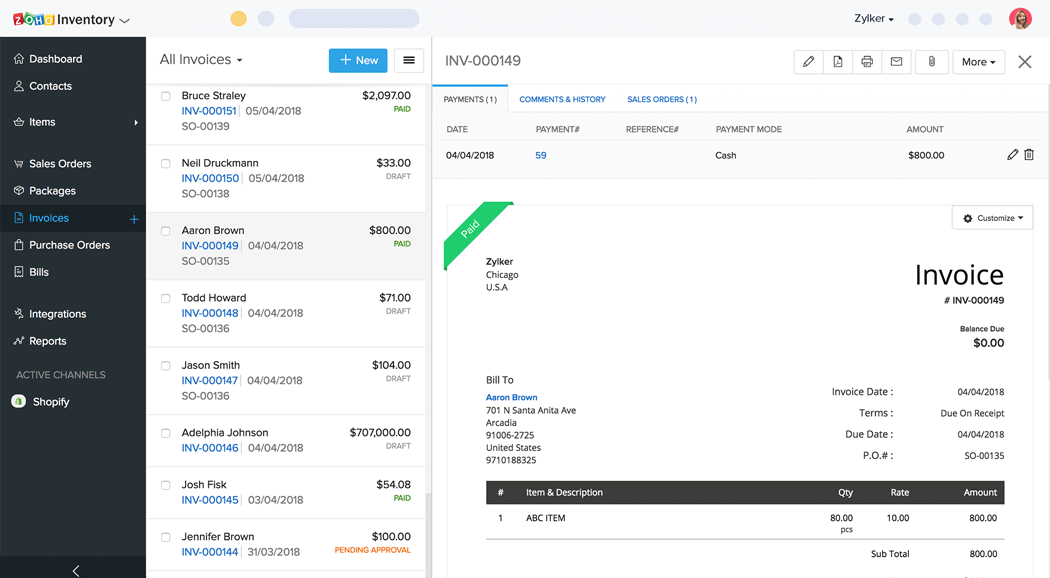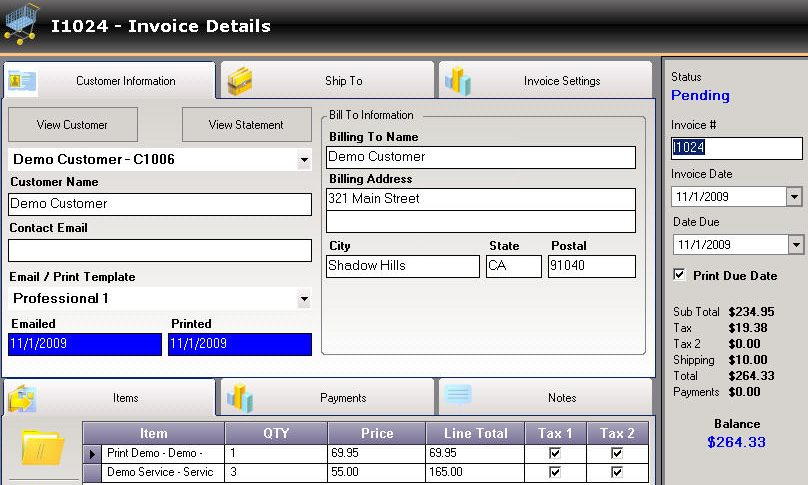Discover the transformative power of small business inventory and invoice software. Designed to empower small businesses, this innovative solution revolutionizes inventory management, invoice generation, and financial operations, unlocking efficiency and growth.
With its intuitive interface and robust features, small business inventory and invoice software simplifies complex tasks, freeing up your time to focus on what matters most: growing your business.
Inventory Management Features
Inventory management software is a powerful tool that can help small businesses save time and money. By automating the process of tracking inventory levels, managing stock, and optimizing ordering, businesses can streamline their operations and improve their bottom line.
Here are some of the key features of inventory management software for small businesses:
Centralized Inventory Tracking
Inventory management software provides a centralized location to track all of your inventory items. This makes it easy to see what you have in stock, where it is located, and when it needs to be reordered. This can help businesses avoid overstocking or understocking, which can lead to lost sales or wasted money.
Automated Stock Management
Inventory management software can automate the process of managing stock levels. This means that businesses can set minimum and maximum stock levels for each item, and the software will automatically generate purchase orders when stock levels fall below the minimum. This can help businesses ensure that they always have the right amount of stock on hand, without having to manually track inventory levels and place orders.
Purchase Order Optimization
Inventory management software can help businesses optimize their purchase orders. The software can analyze historical sales data to determine the optimal order quantity for each item. This can help businesses reduce their inventory carrying costs and improve their cash flow.
Real-Time Reporting
Inventory management software provides real-time reporting on inventory levels, stock movements, and purchase orders. This information can help businesses make informed decisions about their inventory management practices. For example, businesses can use this information to identify slow-moving items or to forecast future demand.
Benefits of Using Inventory Management Software
There are many benefits to using inventory management software for small businesses. Some of the most notable benefits include:
- Reduced inventory costs
- Improved cash flow
- Increased sales
- Improved customer satisfaction
- Reduced risk of stockouts
If you are a small business owner, then inventory management software is a valuable tool that can help you save time and money. By automating the process of tracking inventory levels, managing stock, and optimizing ordering, you can streamline your operations and improve your bottom line.
Invoice Generation and Processing
Invoice software empowers small businesses to create, manage, and track invoices efficiently. It automates repetitive tasks, streamlines processes, and improves accuracy.
By leveraging invoice software, small businesses can:
- Customize invoices: Design professional invoices with custom branding, logos, and templates.
- Automate invoice creation: Generate invoices based on pre-defined templates, reducing manual effort and errors.
- Process payments seamlessly: Integrate with payment gateways to accept online payments, reducing delays and increasing convenience.
Invoice Accuracy and Error Reduction
Invoice software helps businesses minimize errors by performing automated calculations, ensuring accuracy in pricing, taxes, and discounts. It also eliminates the risk of manual errors caused by handwritten or spreadsheet-based invoicing.
Faster Payment Collection
By automating invoice reminders and providing multiple payment options, invoice software accelerates payment collection. Businesses can track invoice status in real-time, monitor overdue payments, and take prompt action to follow up with customers.
Integration with Accounting Systems
Integrating inventory and invoice software with accounting systems is crucial for businesses to streamline their financial operations. Seamless data flow between these systems offers numerous advantages, including improved accuracy, reduced manual entry, and real-time financial reporting.
Improved Accuracy
Integration eliminates the risk of manual data entry errors, ensuring consistency and accuracy across all systems. Automated data transfer reduces the likelihood of mistakes, such as incorrect pricing, product descriptions, or invoice calculations.
Reduced Manual Entry
Automating data transfer between systems significantly reduces the need for manual entry, saving time and effort. This frees up staff to focus on more strategic tasks, such as analyzing financial data or improving customer service.
Real-Time Financial Reporting
Integrated systems provide real-time visibility into financial performance. Businesses can access up-to-date inventory levels, invoice status, and accounting data, allowing them to make informed decisions based on the latest information.
Example: Streamlined Order Processing
Integration with accounting systems enables automated order processing. When an order is placed, the inventory software updates the inventory levels, while the invoice software generates an invoice and sends it to the customer. The accounting system records the transaction, updating accounts receivable and inventory value in real-time.
Mobile Accessibility and Cloud Storage: Small Business Inventory And Invoice Software

In today’s fast-paced business environment, it is essential to have access to your inventory and invoice information anytime, anywhere. Mobile accessibility and cloud storage are two key features of inventory and invoice software that can provide your business with a number of advantages.
With mobile accessibility, you can use your smartphone or tablet to access your inventory and invoice software from anywhere with an internet connection. This means you can check stock levels, create and send invoices, and manage your customers from the palm of your hand. This can be a huge time-saver, especially if you are frequently on the go.
Cloud storage is another important feature of inventory and invoice software. Cloud storage allows you to store your data on a remote server, which means it is accessible from any device with an internet connection. This is a great way to protect your data from loss or damage, and it also makes it easy to collaborate with other team members.
Benefits of Mobile Accessibility
- Access your inventory and invoice information from anywhere with an internet connection
- Check stock levels, create and send invoices, and manage your customers from your smartphone or tablet
- Save time by managing your inventory and invoices on the go
Benefits of Cloud Storage
- Protect your data from loss or damage
- Access your data from any device with an internet connection
- Collaborate with other team members easily
Reporting and Analytics

Inventory and invoice software often offer robust reporting and analytics capabilities that provide businesses with valuable insights into their inventory management and invoicing practices. These tools allow businesses to generate a variety of reports, including:
Inventory Turnover
– Track the rate at which inventory is sold and replaced, helping businesses optimize stock levels and reduce waste.
Sales Performance
– Monitor sales trends, identify top-selling items, and analyze customer buying patterns to improve sales strategies.
Customer Insights, Small business inventory and invoice software
– Gain insights into customer behavior, such as purchase history, payment patterns, and demographics, to tailor marketing and sales efforts.
Data analysis plays a crucial role in helping businesses make informed decisions about inventory management and invoicing. By leveraging the data provided by reporting and analytics tools, businesses can:
– Identify slow-moving or obsolete inventory and adjust stocking levels accordingly.
– Optimize inventory levels to minimize carrying costs and prevent stockouts.
– Improve invoicing accuracy and efficiency by automating invoice generation and tracking.
– Enhance customer satisfaction by providing detailed and timely invoices.
– Make data-driven decisions to improve overall business performance and profitability.
User Interface and Usability
A user-friendly interface is crucial for inventory and invoice software, enabling users to navigate seamlessly and perform tasks efficiently. It eliminates frustration, enhances productivity, and promotes software adoption.
Intuitive Navigation
- Well-organized menus and navigation bars simplify finding specific features and functions.
- Clear and logical menus reduce confusion and save time spent searching for options.
- Keyboard shortcuts provide quick access to frequently used commands, streamlining operations.
Clear Menus
- Menus should be uncluttered and visually appealing, using icons or images for quick recognition.
- Grouping similar functions under specific menus ensures logical organization and ease of use.
- Contextual menus provide relevant options based on the current task, reducing cognitive load.
Helpful Tutorials
- Interactive tutorials or documentation guide users through the software’s features and functionality.
- In-app help sections provide quick assistance and troubleshooting tips.
- Well-written documentation serves as a comprehensive reference for users at all levels.
Examples of Well-Designed Interfaces
Examples of software with well-designed user interfaces include:
- QuickBooks Online: Intuitive navigation, clear menus, and comprehensive help resources.
- Zoho Inventory: User-friendly dashboard, customizable menus, and interactive tutorials.
- FreshBooks: Simple and visually appealing interface, with easy-to-use menus and helpful tooltips.
Security and Compliance
Inventory and invoice software should prioritize security to protect sensitive business information, ensuring compliance with industry regulations.
Data encryption safeguards data at rest and in transit, preventing unauthorized access. Access control restricts user permissions, limiting data exposure. Compliance with regulations like PCI DSS and GDPR ensures adherence to data protection standards.
Examples of Software with High Security Standards
- NetSuite: Complies with PCI DSS and SOC 2 Type II, offering data encryption and role-based access control.
- Sage Intacct: Meets SOC 2 Type II standards, featuring AES-256 encryption and two-factor authentication.
- QuickBooks Online: Adheres to PCI DSS and SOC 2 Type II, providing bank-level security and automatic data backups.
Conclusive Thoughts

Embrace the future of inventory and invoice management with software tailored to the unique needs of small businesses. By streamlining operations, enhancing accuracy, and providing valuable insights, this solution empowers you to make informed decisions, optimize cash flow, and achieve lasting success.
FAQ Resource
What are the key benefits of using small business inventory and invoice software?
Small business inventory and invoice software offers numerous benefits, including improved inventory accuracy, streamlined invoice processing, reduced manual errors, enhanced financial reporting, and increased efficiency.
How can inventory and invoice software help me save time and money?
By automating inventory tracking, invoice generation, and payment processing, small business inventory and invoice software frees up valuable time, allowing you to focus on more strategic tasks. Additionally, it reduces manual errors, minimizing costly mistakes and saving you money.
Is small business inventory and invoice software easy to use?
Yes, most small business inventory and invoice software solutions are designed with user-friendly interfaces and intuitive navigation. They often provide clear menus, helpful tutorials, and support resources to ensure a smooth learning curve.